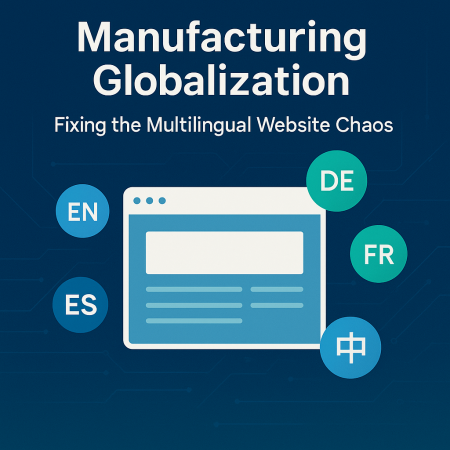As global competition intensifies, a multilingual website is no longer just a digital brochure for manufacturing companies—it is the primary touchpoint for international buyers, distributors, and partners.
Yet for many manufacturers, every website update becomes a cross-departmental “crisis”:
A two-sentence change in Chinese triggers a chain reaction—English, German, Spanish, French and more languages must all be updated. Marketing, engineering, translation, IT, and overseas teams scramble to align. The results? Misaligned terminology, broken layouts, inconsistent versions, and long delays.
This article breaks down why multilingual website updates often collapse into chaos—and how Landelion helps manufacturing companies build a scalable, stable global website system through the right tools, systems, and workflows.

1. Why Do Multilingual Website Updates Keep Failing?
The complexity of multilingual content creates an exponentially higher operational burden. The root causes fall into three major categories:
1) Update workload multiplies with every new language
A minor update in the source language requires full re-translation, review, and publishing across all language versions. What should be a simple task quickly turns into a time-consuming workflow.
💡Landelion Insight: Manufacturing websites contain large amounts of repeated technical content. Without a Translation Memory (TM) or Translation Management System (TMS), teams waste massive amounts of time redoing the same work.
2) No real version control system
China HQ, global marketing, IT, translators, regional offices, distributors—everyone holds a different “latest version.”
This causes inconsistent product data, outdated safety information, and conflicting terminology.
💡Landelion Insight: Without version control, a multilingual website naturally falls into a “multiple versions running in parallel” failure state.
3) Communication chains are too long
Updating one paragraph often requires: Marketing → Design → IT → Translation → Overseas teams → Final reviewers → Back to CMS.
Every added reviewer increases the chance of errors, rework, and delays.
💡Landelion Insight: Without a unified CMS/TMS workflow, communication becomes the bottleneck—and the longer the chain, the more errors occur.
2. The Real Solution: Systems, Tools & Workflows Working Together
To turn a multilingual website from a burden into a business asset, manufacturing companies must upgrade three pillars: CMS foundation → Translation technology → Standardized workflows
Pillar 1: A Multilingual-Ready CMS Is the Foundation
The choice of CMS determines whether global website operations are smooth—or a constant fire-drill.
A proper multilingual CMS must support:
✔ Clear parent–child language relationships
✔ Automatic prompts when source content changes
✔ Modular, reusable page structures
✔ Built-in multilingual SEO configuration
✔ Scalable architecture for future expansion
💡Landelion Insight: Choose the right CMS and multilingual updates become routine. Choose the wrong one—and every update feels like disaster recovery.
Pillar 2: Integrating Translation Technology (TM/TMS/Termbase)
Modern multilingual operations cannot rely on Word documents and manual copy-paste. Essential tools include:
✔ Translation Memory (TM)
Avoid re-translating identical content—common in manufacturing manuals, product specs, and solution pages.
Benefit:
Lower translation costs, faster updates, consistent terminology.
✔ Terminology Database (Termbase)
Defines the correct translation of technical terms across all languages:
“servo drive”
“latency”
“overload protection”
“robotic welding cell”
Benefit:
High technical accuracy + global brand consistency.
✔ Translation Management System (TMS)
Automates submissions, translation workflows, approvals, and CMS publishing.
Benefit:
Shorter delivery cycles + zero version confusion.
💡Landelion Insight:
Without TM, you pay repeatedly for the same sentences. Without a Termbase, terminology inconsistencies damage technical credibility more than spelling errors ever will.
Pillar 3: Workflow Optimization—From “Firefighting” to Stable Operations
A scalable update flow should look like this:
🔹Update source language
🔹Push to TM/TMS → auto-reuse existing translations
🔹Terminology validation
🔹Multilingual drafts sync automatically in CMS
🔹Regional teams review localized nuances
🔹Unified publishing + version archiving
💡Landelion Insight: Once workflow is standardized, multilingual updates become faster, more predictable, and far less stressful.
3. Landelion’s Build & Grow Model: Turning Websites Into Growth Engines
A successful global website is not built once—it must perform continuously.
Phase 1: Build — Set the foundation right
Includes:
Global site architecture
UX and modular CMS design
Multilingual structure & SEO planning
Content hierarchy for technical and solution pages
💡Landelion Insight: If the Build phase is done right, every future multilingual update becomes fast and stable.
Phase 2: Grow — Turn your website into a lead-generation system
Focus areas:
Multilingual content updates
SEO improvements
Speed & performance optimization
Analytics integration
Continuous UX + technical refinement
💡Landelion Insight: A multilingual website is not a one-time project—it's a long-term acquisition engine.
4. Why Manufacturing Companies Need Professional Website Localization
Manufacturing companies face unique challenges:
Complex product technology
Long decision cycles
Dealers, integrators, and engineers involved
Certifications (CE, UL, FCC, ISO) tied to website claims
Technical documentation embedded in the site
A multilingual website is not just “marketing material”—it is a technical asset influencing procurement, compliance, and trust.
💡Landelion Insight: If your multilingual site is poorly localized, overseas buyers immediately question your engineering reliability. In 2025, website localization is brand credibility.
5. Conclusion: Make Multilingual Updates a Growth Driver, Not a Burden
By combining:
🔹A multilingual-ready CMS
🔹Translation Memory + Terminology Database
🔹A scalable Translation Management System
🔹A standardized update workflow
manufacturing companies can completely eliminate the chaos of multilingual updates and operate confidently in global markets.
Landelion • Multilingual Website Localization for Manufacturing
We provide:
✔ Multilingual CMS architecture
✔ Technical website localization (20+ languages)
✔ Global SEO strategy & implementation
✔ Continuous content + SEO optimization
✔ Translation Memory & Termbase setup
✔ Full linguistic, UX, and compliance alignment
Turn your website into a true lead-generation machine—not a maintenance headache.
💌 Free Resource
Follow Landelion on WeChat and reply with [多语言] to download “Multilingual Website Tools Map”—a one-page cheat-sheet on how to select the right CMS/TMS/TM.

👉 Contact us for your personalized global website strategy.




